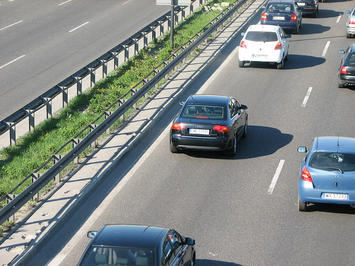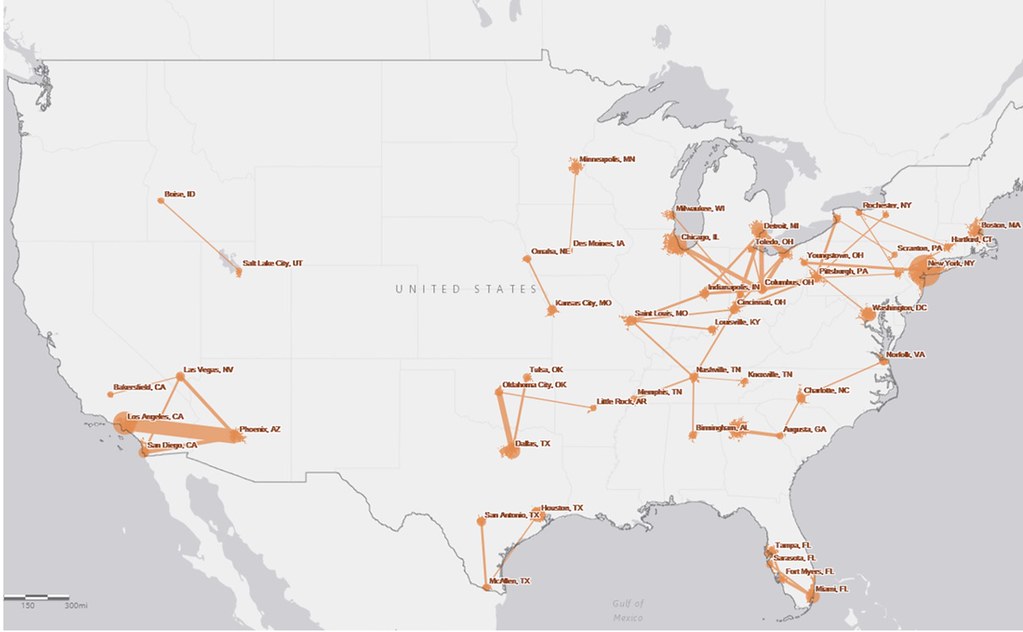
A theme de rigour at transportation conferences these days is Americans’ reduced affinity for driving. It is a pervasive premise: that young people and urbanites only want “to get from point A to point B.”
Such claims ring true in numerous dense urban settings where transportation network companies (TNCs) such as Lyft and Uber, as well as bikesharing and carsharing are all flourishing. Car-free living is on the rise.
However, trends on longer distance trips suggests caution in making sweeping claims about how people are getting around. On suburban trips, auto-dependence has barely changed. Furthermore, a study I conducted shows that many intercity travelers can hardly avoid driving or flying on trips between 100 and 400 miles, even if they want to.
The difficulty of avoiding cars on city-to-city trips surprised even us longtime observers, considering that between 2006 and 2013, a bevy of new options such as BoltBus, Go Bus, and Megabus emerged, and Amtrak added significant new service. Nevertheless, the expansion of both bus and rail routes has recently slowed, and driving has gone up sharply over the past few years, partially due to a fall in gasoline prices. Tech-oriented innovations around non-driving alternatives are stuck in slow gear; TNCs are not yet available or affordable on most trips of more than 100 miles.
When “Ground Transportation Gaps” Make Driving Unavoidable
To assess what all this means for travelers, I created the term “Ground Transportation Gaps” to denote corridors in the 100 – 400 mile range, linking metropolitan areas with populations of more than 500,000 that lack both express coach line and rail service. I also dub a corridor a “Gap” when these modes exist but are unacceptably slow (< 25 mph) due to the need to make time-consuming transfers.
I differentiate between express coach lines like Megabus and conventional bus lines like Greyhound for the simple reason that many travelers--rightly or wrongly--exclude conventional lines from their “choice set.” Many people are apprehensive about bus depots, while others balk at the uncertainty of the travel experience. For others, it’s about image or status. Conversely, express coach lines have at least partially broken through these barriers by emphasizing curbside pickup, fast service, and guaranteed seating for all ticket holders.
Getting around without a car can be exceedingly difficult in a Ground Transportation Gap. Travelers can often fly, but the “airport hassle factor” persists and carriers charge big bucks for last-minute bookings. For these among other reasons, the number of flyers on short-hop routes has fallen sharply over the past several decades.
The largest Gap is Los Angeles – Phoenix, which, by my estimate, generates 2.5 million trips per year, while Cleveland – Detroit, Chicago – Columbus, OH, Dallas – Oklahoma City and Las Vegas – Phoenix, generate more than a million, as the following interactive map shows. In the Southeast, Cincinnati – Nashville, Miami – Ft. Myers, and Tampa – Sarasota see huge volume. Good luck to a traveling party of two that dislikes driving but doesn’t book in advance: they often must either “Go Greyhound,” or pay at least $1,000 for a pair of roundtrip flights. “We’ll just drive” or “we’ll stay home,” is no doubt a common response.
“Ground Transportation Gaps”
Examples of Heavily Traveled Routes w/o Express Coach Line or Rail Service

To access interactive map, click here.
About 30% of intercity routes linking metro areas with populations of 500,000 or more are full-blown Gaps, while many others have but one or two Amtrak or express coach departures daily, testing the will of those who try to avoid driving. Gaps constitute an overwhelming share of routes to smaller metro areas, including all of those involving Columbus and Dayton, OH, Phoenix, AZ, and Tulsa, OK, which have no Amtrak trains or express coach line service at all.
Technology to the Rescue?
Private innovations will likely help close the gaps. Lyft and Uber are eying longer-distance markets. As fuel costs rise, Megabus and other bus lines have begun expanding again, and the fast-growing German-based Flixbus will reportedly launch U.S. service next year.
Axle Travel, a startup, is testing a door-to-door service in the Northeast that integrates bus services and TNCs onto a single ticket. App-based services like Europe’s blablacar.com, which allows drivers making intercity trips to find others riders for a fee, may eventually gain traction here. In addition, autonomous cars may push everything in a new direction.
But public agencies can speed things along, even with strained budgets. Express carriers need help finding attractive pickup and drop-off locations, which is becoming a major problem. Boston, Denver and Washington, DC have created dedicated terminals for intercity bus lines that are largely financially self-supporting. State governments in California, Michigan and Oregon have filled gaps using private bus lines to feed rail corridors as part of the growing Amtrak “Thruway” program.
So, when someone claims that travel is now only about “getting from Point A to Point B,” remind them that there is a four-hundred-mile-wide gap in their thinking. New alternatives for intercity travel may be coming. What remains to be seen is how many Americans are ready to hop on board.
Joseph Schwieterman, Ph.D., is professor of Public Services and director of the Chaddick Institute for Metropolitan Development at DePaul University in Chicago. He is the author of a widely read annual report on the intercity bus industry.
Photo: Przemek P., via Flickr, using CC License.












